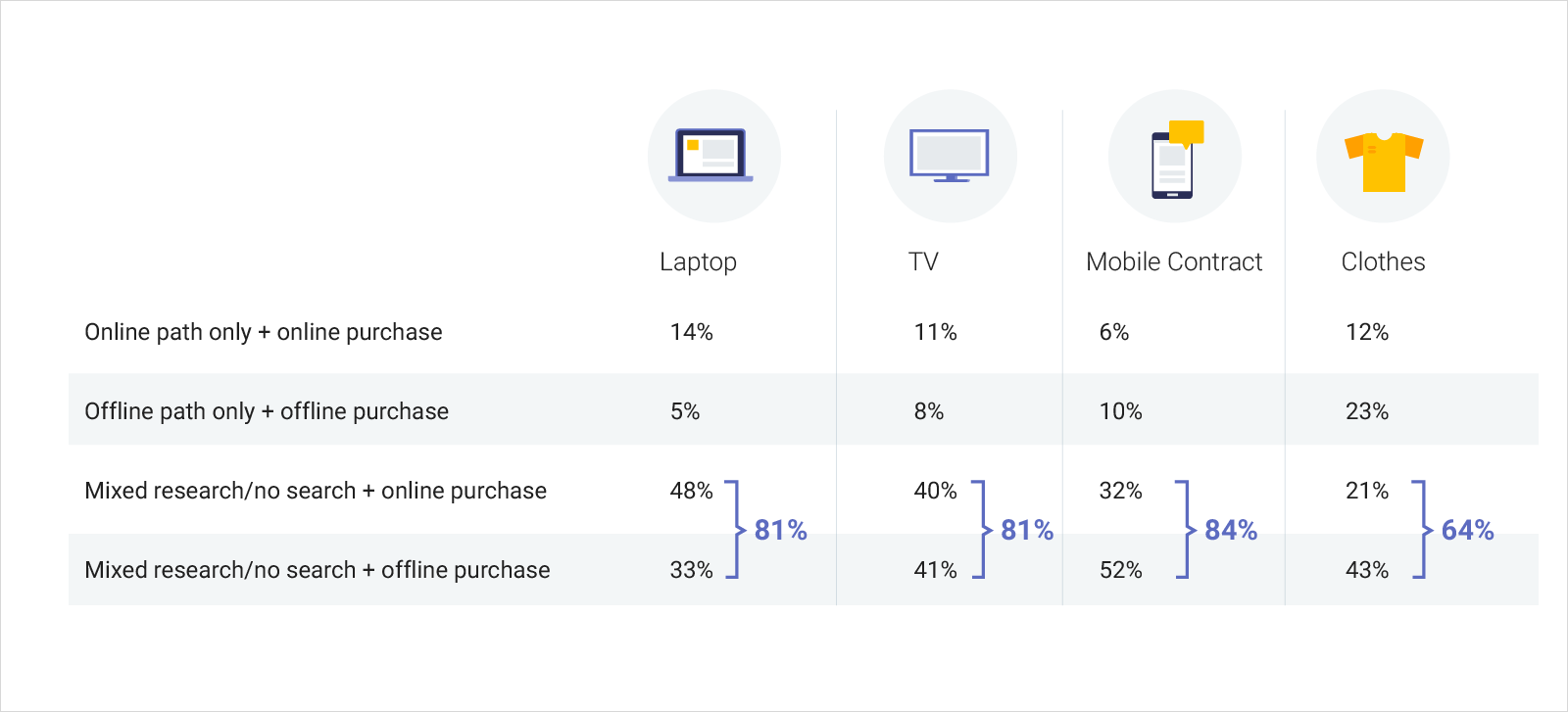Half the money I spend on advertising is wasted; the trouble is I don’t know which half.
John Wanamaker, Pioneer in Marketing
John Wanamaker, credited inventor of the price tag and known pioneer in both department stores and marketing, famously proclaimed, “half the money I spend on advertising is wasted; the trouble is I don’t know which half.”
Fast forward 100 years, and today’s no different. The complexity of fully realized omni-channel orchestration may offer more opportunities to communicate, but it introduces new challenges as well. Customers today have more choices, operate multiple devices, consume around the clock, interact through multiple touch-points, and participate in both online and offline interactions.
Google CEE and IPSOS carried out a research study surveying 4,200 consumers across four categories of products and services, including laptop, TV, mobile phone contract, and clothing/foot-ware purchases. The results show just how highly fragmented today’s customer journey is across multiple channels and devices.

Electronic purchases showed a significant increase in online-only interactions as opposed to mobile phone or apparel, where the offline path is clearly preferred. However, nothing dominated as much as the combination of the two. For most products, over 80% of consumers opt into researching online and purchasing offline, or researching offline and purchasing online.
This is a clear indication of the importance of omni-channel communication: unified, consistent communication across every customer channel. We also need to be able to track and analyze the incoming omni-channel customer data – so we don’t end up like Wanamaker. Luckily, we have the tools today to measure the efficiency of each marketing effort, determining which are key in driving sales results.
It’s a tactical procedure called attribution modeling, where you attribute a sale to a given piece of marketing. Through this, you can decide where to allocate future resources in order to maximize your return on investment. As it turns out, there are quite a few attribution models out there, ready to assist in navigating your marketing efforts as the number of distribution channels grow exponentially.
So what are we waiting for? Let’s break them down.
Table of Contents
Key Takeaways
- The complexity of the omni-channel customer journey is as elaborate as the buyers themselves, hence the importance of an omni-channel analytics strategy.
- Attribution modeling is the best method to track efficiency, accountability and transparency in your marketing efforts. Understanding which particular model to use effects the desired results.
- Data-driven attribution models are regarded as the best, but requires data-focused omni-channel reporting. There are alternatives! Refer to the our flowchart.
- Attribution models unlock marketing channel oversight, displaying which activities are performing, preferred and drive needed conversions.
- Zero-in on your most profitable customers and marketing campaigns by understanding the value of new customers vs. the cost to acquire them.
Listen to this article
Setting the Scene with an Omni-Channel Example.
To bring relevance to each definition, let’s take into consideration the following customer journey:
Karla stumbles across your website from an ad you placed on social media. She stays for a quick browsing session and eventually subscribes to your newsletter. The following week she receives one of your emails, then dials the call center with a couple questions before returning directly to the e-shop where she makes her purchase online.

As previously depicted in How to Foster Customer Loyalty Through Omni-Channel Communication, true omni-channel analytics solutions incorporate both online and offline communication channels, so we went ahead and included both in our example. Let’s learn about each attribution model, and follow along Karla’s example to see how they differ when analyzing our omni-channel customer communication.
Attribution Models, Characteristics and Comparisons.

Single-Touch Attribution Models.
Although single-touch attribution models boast a low-level of complexity, no complicated calculations and allow for easy implementation and minimal investment, they only give credit to one touch-point along the conversion path. Which, essentially, oversimplifies the omni-channel customer journey and can lead to serious misconceptions. We’ll blast though them anyway, since some are set by default (thanks Google Analytics).
First-Touch Attribution Models
First-touch attribution models simply give 100% of the credit to the first touch-point within the customer journey, regardless of whether or not that campaign directly influenced the resulting purchase.

Omni-Channel Attribution Example: In Karla’s case, credit would be wholly allocated to Social Ads. Whether it was love at first sight or an acquired taste, it’s this particular factor that is deemed most important. Besides, if Karla never discovered the store, she would have never made the purchase, right?
First-Touch Pros: Since the first-touch approach has an immense focus on the top-of-the-funnel marketing activity, it helps discover what content is driving the most new customers. It’s best used with short sales cycles, since it quickly promotes activities that attract large audiences. As a result, you’re more likely to beat out the competition by capturing these traffic drivers.
First-Touch Cons: On the downside, first-touch does not take into consideration the majority of touch-points that actually convert the client into a purchase. This lack of attention to the middle and bottom-funnel activity may result in a less attractive conversion rate.
Last-Touch Attribution Models
On the opposite end of the spectrum, the last-touch attribution model provides 100% of the credit to the last interaction before the purchase, essentially shedding significant light on the conversion process as opposed to raising awareness of your company.

Omni-Channel Attribution Example: With last-touch, Karla’s direct visit to the website receives credit for the customer purchase since it was the last direct influence before reaching the point of sale. It doesn’t matter how many customers found the company or where they fell-off along the customer journey, it’s Karla’s crucial tipping-point before purchase that’s being tracked here which is why that last-click attribution is considered most valuable.
Last-Touch Pros: If the path to improving customer conversion is a clear company objective, last-touch attribution modeling provides true insight into this process and can play an active part in earning revenue.
Last-Touch Cons: With last-touch, we’re once again blatantly ignoring active parts of the customer journey. In this case, the initial steps along the conversion path (and that’s not even counting impressions). Thus, we’re missing vital information about what drove the customer’s path, and the various scenarios that led them.
Multi-Touch Attribution Models
As described by the Boston Consulting Group in How Digital Leaders are Transforming B2B Marketing, the simplicity of single-touch attribution methods create a gap in our data analysis. Multi-touch attribution models compensate for that gap by including more steps in the customer journey, since for the majority of omni-channel marketing campaigns, you don’t want to give just one channel all the credit. Take a look at how these models employ multi-channel attribution in their omni-channel reporting.
Linear Attribution Models
As one of the simpler multi-touch attribution models, the linear attribution model distributes credit evenly amongst every single touch-point within the customer journey. Assuming your omni-channel statistics records multiple events of the same type of touch-point, such as several direct website visits, each would receive their own allocated credit, which could be added up to show recurring value.

Omni-Channel Attribution Example: Back to Karla. In a linear attribution model, all four touch-points–the social ads, email, call center and direct visit–would receive equal credit for the conversion. They all played a continuous part in assisting in her decision process.
Linear Pros: Linear attribution modeling is a more holistic approach that doesn’t skip any stage in the marketing funnel. Similar to the previous single-touch models, the math is kept simplistic, though it provides an upgrade when it comes to calculating ROI accuracy.
Linear Cons: The varying impact of marketing touches. In other words, a more impactful touch might get dwarfed by repetitious touches. In an omni-channel retail environment, touch-points aren’t all created equally; some play a bigger role in convincing customers to make a purchase.
Position-Based Attribution Models
Instead of providing equal credit to each touch-point, the position-based attribution model places an emphasis on the first and last touch-points–assigning 40% credit to each–while the remaining 20% is divided equally amongst the remaining touch-points.

Omni-Channel Attribution Example: The Social Ad first-touch brought Karla in as a customer, and the Direct visit last-touch sealed the deal, so they each receive 40% credit. The remaining touch-points, Email and Call Center, now divide up the remaining 20%, taking 10% each for their part in the journey.
Position-Based Pros: Essentially, position-based attribution modeling is a combination of the two single-touch attribution models, with a linear attribution model sand-whiched in the middle. What this does is appoints an aggressive growth strategy that blends the focus on both incoming customer interest and conversion improvement.
Position-Based Cons: Unfortunately, by using this type of omni-channel analytics strategy, you’re diluting the value of each touch-point found in the middle. This lack of mid-funnel activity monitoring may ignore key conversion influencers; proving there’s definitely room for improvement.
Time Decay Attribution Models
A time decay attribution model allocates more credit to touch-points occurring closest to the customer purchase.While we include multiple touch-points within the customer journey, we’re assuming that the closer we are to the conversion, the more influence it has on the purchase.

Omni-Channel Attribution Example: As Karla makes her purchase, the paid social media ad receives some credit, since it played its part introducing the company and product. Email receives a little more, since it appears a little later. The call center conversation gets even more credit, while direct visitation, as the final touch-point, is allocated the most.
Time Decay Pros: Time decay attribution modeling attempts to include all of the stages of the customer journey, implying that more value is found the closer a prospect is to being a customer. This thought process often leads to increased loyalty; since touch-points found closer to a conversion are more highly valued, heightened attention and financial investments are made towards mid-funnel and bottom-funnel activity. Nurturing each customer as they come closer to planning their purchase.
Time Decay Cons: The typical argument against using time decay is that the top of the funnel activity will always be undervalued since it’s furthest away from the customer purchase. This sequencing of touch-points will never truly convey the importance of each touch-point when evaluating why a customer made their purchase.
Data-Driven Attribution Models
Adopting anything other than a data-driven attribution model could be a costly mistake. It’s adaptive, reactive and much better than its traditional, heuristic counterparts.
Lucia Hraskova, Customer Analytics Consultant at Exponea
One attribution model aims to solve the above-described limitations of all the other models — the data-driven attribution model. More advanced and unbiased, data-driven attribution uses machine-learning to analyze which touch-points drive sales. As it learns and adjusts over time, credit is then divided based off the results, providing weighted scoring for each marketing channel.

Omni-Channel Attribution Example: Karla’s data-driven approach discovers that social was just somewhat successful, allocating 20% credit since it did catch her interest. The email performed even better, receiving 40% credit for getting Karla to interact with all the links and spend time reading the details. The call center gets 30% of the credit, since discussions were long, questions were answered and it all ended with a positive call to action. Direct gets the remaining 10% of credit since it was just used for the purchase, and Karla didn’t spend much time exploring the website.
Data-Driven Pros: This sort of technical algorithm can be customized to your own accounts and can include an assessment of the chosen key-words used for your marketing efforts. Data-driven is regarded as one of the best attribution tracking models since it removes much of the guesswork involved by including data to quickly identify ineffective channels and push the money-making efforts. Constantly updated – constantly relevant.
Data-Driven Cons: A huge downside to data-driven attribution models is the requirement for large quantities of high-quality, historical data. This exclusivity, reserved for a larger audience, is due to the need to feed the algorithm with enough data for the entire model to accurately produce reliable results.
Do you have enough data to make the cut? What’s the best alternative if you don’t? Find out which attribution model is right for your omni-channel analytics strategy using our handy flowchart below.
Flowchart: Choosing the Right Attribution Model
As we’ve established by this point, there are more than a few approaches to applying attribution models when analyzing your omni-channel performance, however they will undoubtedly vary from one company objective to another. Nonetheless, selecting the most appropriate attribution method will help you better measure your marketing activities, and better define touch-point that outperform others. Here’s a quick flowchart to help get you orientated.

Final Thoughts
Marketers need to calculate the ROI of their various marketing activities. They need the assurance that each activity has the right impact on the customer journey, and if it doesn’t they need that information quickly as to switch their focus to another avenue.
Attribution models were devised to solve this issue, though they have never been one-size-fits-all; different models fit different industries and different companies. As the pros and cons have depicted, they come with the understanding that the results will likely never be 100% accurate; It’s not perfect, though it’s as perfect as we can get for now.
Nonetheless, they can improve the more you continually test your models, actively compare, and never choose to settle with just one method. Only then can you achieve the desired efficiency, accountability, transparency and feedback. As the saying goes, every minute spent is an hour earned, so get moving with your omni-channel analytics strategy, so you can succeed.
Find out how Exponea can walk you through the best omni-channel experience for your business, by booking a quick demo. We can even help in choosing the right analytical approach to elevate your return on investment.
Want more? We’ve got you covered
What Should You Read Next? Author's Hand-Picked Recommendation:
Stop Advertising To Your Customers
75% of retailers consider omni-channel communication an essential part of their business strategy. Where do you stand?




 Blog
Blog
 Spotify
Spotify SoundCloud
SoundCloud Apple Podcasts
Apple Podcasts Google Podcasts
Google Podcasts Stitcher
Stitcher Anchor
Anchor






